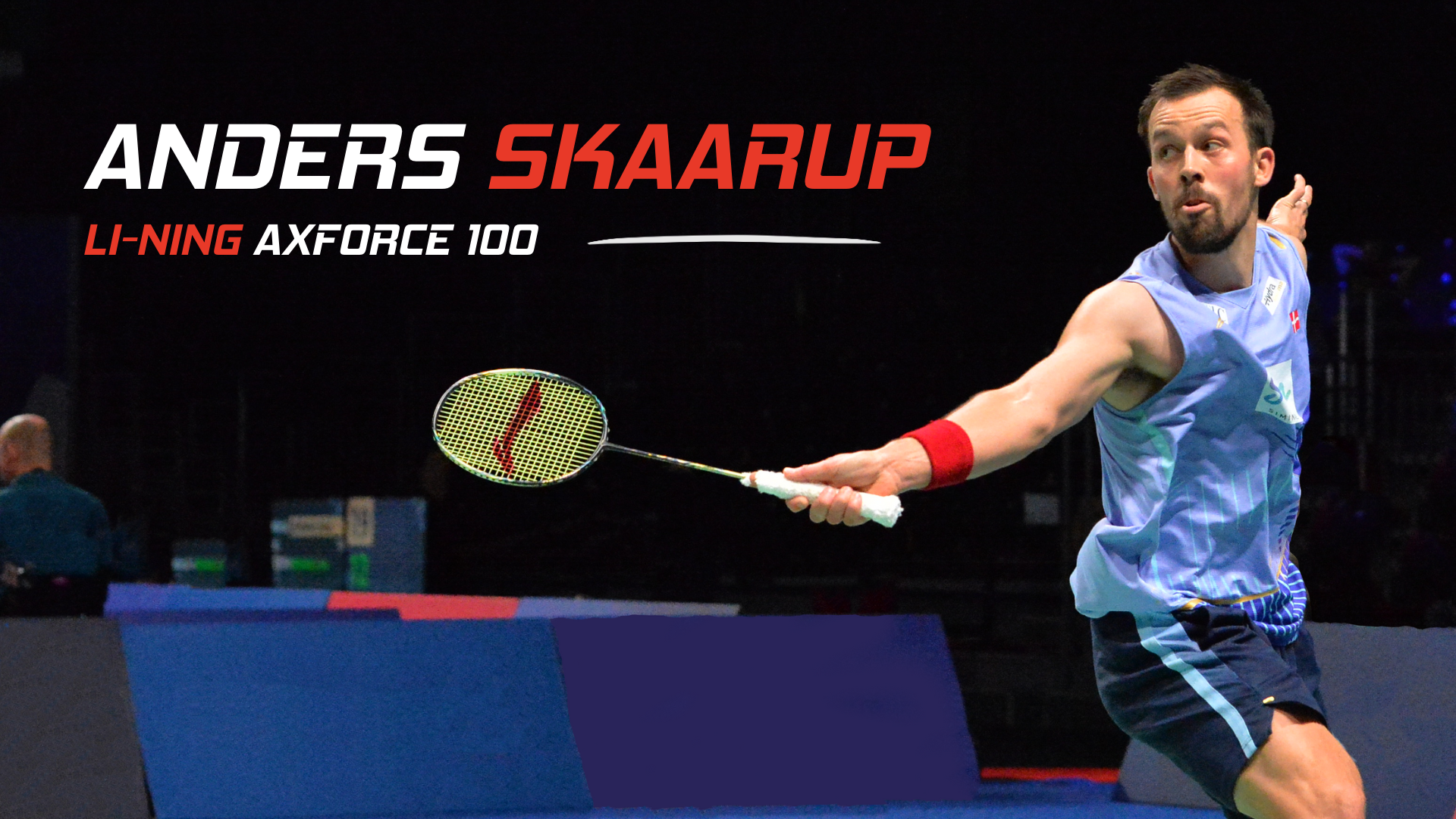GUIDE: HOW TO FIND YOUR NEXT BADMINTON RACKET!
Are you looking for a new badminton racket but finding it hard to choose the right one? In this guide, we make all the technical details easy to understand, so hopefully, it will be much easier for you to find your next badminton racket.
When choosing a new badminton racket, start by looking at 3 things!
But instead, it's the racket's:
- Balance
- Flexibility
- Weight
These are the three most important topics to read about before settling on a specific racket.

Anders Skaarup plays with the Li-Ning AXForce 100

Balance:
All badminton rackets, regardless of the manufacturer, are divided into three type of racket balance:
- Head Heavy
- Even Balance
- Head Light
HEAD HEAVY BADMINTON RACKET:
No matter how much you know about badminton rackets, you've probably come across the term "head heavy badminton racket" – but do you know exactly what it means?
A head-heavy racket means that the racket’s balance point, i.e., where the racket's weight loads are placed, is further up toward the racket head. The advantage of this weight distribution is very clear – POWER! All head-heavy badminton rackets are designed with the aim of maximizing power. You can compare a head-heavy racket to a hammer.
The hammer can drive the nail hard because the weight is far out. If the hammer's head were closer to the hand, you wouldn't be able to strike as hard, and therefore wouldn't be able to drive the nail as deeply.
This is exactly how a head-heavy badminton racket functions!
ADVANTAGES:
You will gain more power in your shots, allowing you to hit longer clears and harder smashes.
DISADVANTAGES:
You compromise on racket speed and control since it’s harder to maneuver a head-heavy racket compared to one with the weight distributed closer to the handle.
If you're interested in a head-heavy Li-Ning badminton racket, you can see our selection right HERE!
HEAD LIGHT BADMINTON RACKET:
It might be obvious, but a head-light badminton racket is the complete opposite of a head-heavy racket.
There are many reasons, but the main one is that the racket’s weight is placed in the handle, giving you the best control over the shuttle since it’s much easier to maneuver. In addition to control, you also get a faster swing, which is great in fast, flat gameplay like in doubles.
For these reasons, a head-light badminton racket is preferred by beginners and doubles players.
ADVANTAGES:
You get the best conditions for optimizing control and significantly increasing swing speed, which is particularly beneficial in fast doubles gameplay.
DISADVANTAGES:
You get minimal assistance with power from the racket, so if you’re looking for a racket that generates power, a head-light one is not the best choice.
We always have a large selection of head-light badminton rackets from Li-Ning. Find them right HERE!
EVEN BALANCE BADMINTON RACKET:
If you can’t decide between a head-light or head-heavy racket, then an even balance racket might be for you.
This is a neutral racket that offers a great combination of the functionalities of both head-heavy and head-light rackets. That’s why an even balance racket is often called a control racket. So, if you’re looking for a racket with good control, decent power, and swing speed – you should look for an even balance weight distribution.
ADVANTAGES:
An even balance racket is an all-round racket that provides a good combination from both worlds, with maximum control.
DISADVANTAGES:
It’s hard to find downsides with these types of rackets, but the basic drawback is that an even balance racket doesn't specialize in any one area – it’s meant to be a mix of both worlds.
We always have a wide selection of even balance badminton rackets from Li-Ning. Find them right HERE!
FLEXIBILITY:
All badminton rackets, regardless of manufacturer, are divided into 3 weight distributions:
There are roughly 3 different types of flexibility - also called stiffness.
- Flexible
- Medium Flexible
- Stiff
FLEXIBLE BADMINTON RACKET:
Well! A flexible racket, as you might have guessed, has an incredibly soft racket shaft. This allows you to get more power in your shots, as the racket "bends" more and thus generates more force for your shot.
In fact, many people play with a flexible racket - it's often beginners, youth players, or older players who use a flexible racket to get more distance in their shots.
ADVANTAGES:
You can achieve more power and thus hit longer clears and harder smashes.
DISADVANTAGES:
Due to the soft shaft, you may be challenged on precision, and it can therefore be harder to control the shuttlecock. However, you need to have a basic good technique before this becomes noticeable.
Of course, we always have a wide selection of flexible badminton rackets from Li-Ning. Find them right HERE!
MEDIUM FLEXIBLE BADMINTON RACKET:
Medium flexible?!? What is that?
Well, it's quite straightforward. A medium flexible racket is in between a flexible and a stiff racket.
Most tournament players - that is, badminton players who play tournaments, team matches, and people who have played badminton for several years and have a basic technique - should always choose a medium flexible badminton racket. This way, you get the best of both the flexible and stiff racket worlds.
ADVANTAGES:
You get the best combination, ensuring good technique and power in your shots.
DISADVANTAGES:
You compromise on power more than with a flexible racket.
We have a wide selection of badminton rackets with medium flexible shafts. Find them right HERE!
STIFF BADMINTON RACKET:
Many players use a stiff badminton racket - but very few should actually play with them. But why?
A stiff racket is, quite simply, the exact opposite of a flexible racket - "No shit Sherlock!". A stiff racket bends very little in the shaft, which means the racket provides minimal power to your shots, making it "hard" to play with. However, a stiff racket offers the absolute best conditions for your technique.
That's why most top players use badminton rackets with stiff shafts - though many also play with medium flexible badminton rackets. So remember, just because your idol plays with a certain racket doesn't mean it's the right one for you, as it might be too "hard" to play with.
We therefore only recommend stiff badminton rackets to advanced/elite players.
ADVANTAGES:
You get the best conditions for your technical skills.
DISADVANTAGES:
The racket contributes very little to increasing your power, so you have to generate the power yourself.
Tempted by a stiff badminton racket? Find them right HERE!
WEIGHT:
Li-Ning produces rackets in the following weight classes:
- 3U (85-89 Grams)
- 4U (80-84 Grams)
- 5U (75-79 Grams)
- 6U (70-74 Grams)
- 7U (65-69 Grams)








